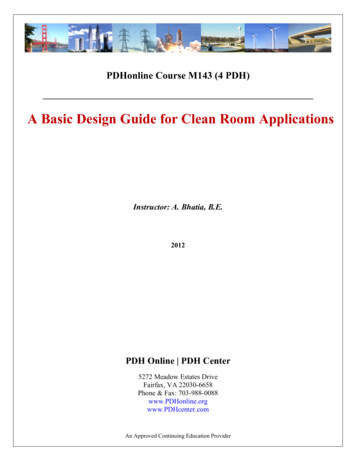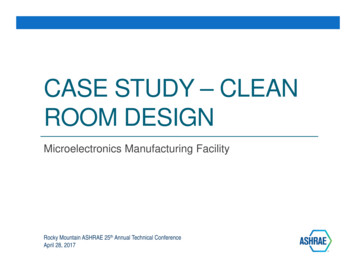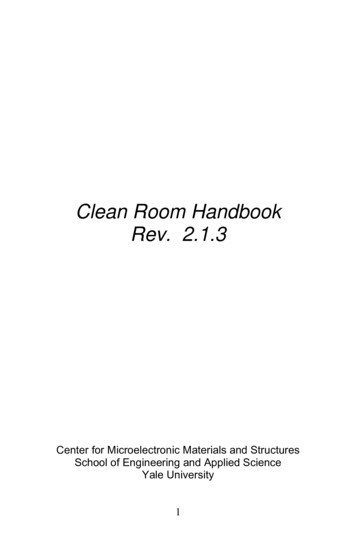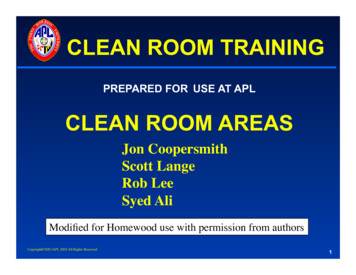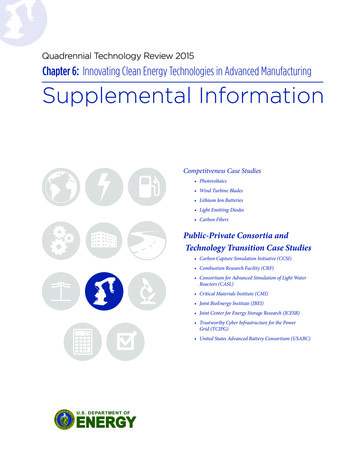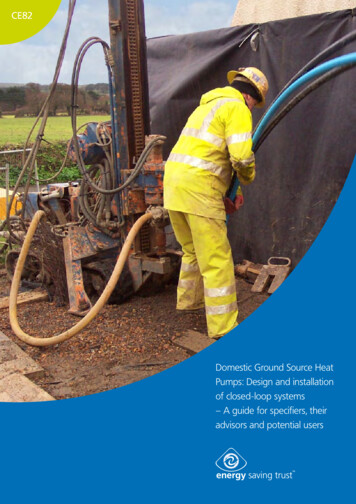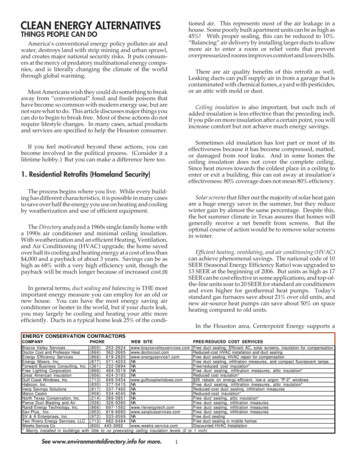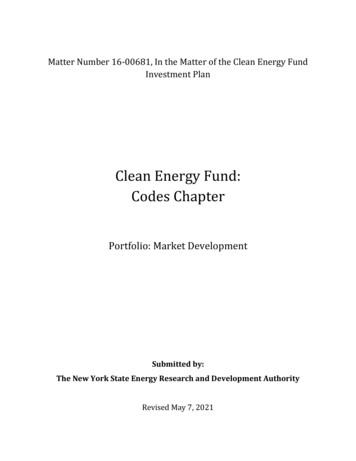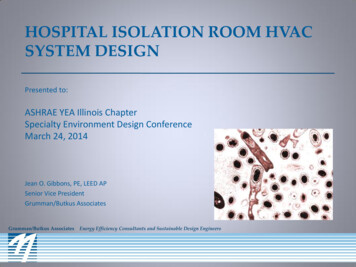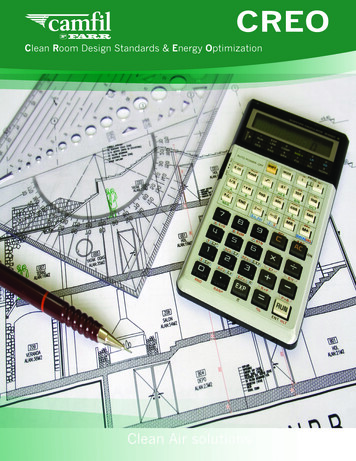
Transcription
CREOClean Room Design Standards & Energy OptimizationClean Air solutions
Clean Room Design Standards & Energy OptimzationAbstractCleanCamfil Farr Solution Systems (CFSS)2- CREO (Clean Room & Energy Optimization)3- Software Analysis Tools3Theory4- Mass Flow Balance4- Particulate Balance4- Particulate Balance Equations5- Different Clean Room Systems6Air Handling Systems7- Recirculation & Reduction of Velocity7Life Sciences Industry Standards8- Clean Rooms823- EU GGMP10- Outdoor Particle Concentrations11- Internal Particle Concentration11- Start-up Concentration12Air Filters13- HVAC Air Filter Standards14Summary15Copyright Camfil Farr 2012The contents herein are not to be copied, reproduced, printed, published, posted, displayed, incorporated, stored in or scanned into a retrieval system ordatabase, transmitted, broadcast, bartered or sold, in whole or in part without the prior express written permission of Camfil Farr. Unauthorised duplication isstrictly prohibited and is an infringement of National and International Copyright laws.Page 1
AbstractClean rooms today are high technology solutionswith high or very high demands on the aircleanliness level. Not only particulate matter butalso airborne molecular contaminants (AMC) areaddressed in more and more applications. Thereforeit is important to estimate the level of air cleanlinessin the cases of new production of, or reconstructionof a clean room.The air cleanliness level in a clean room isdependent on the quality of the supply air,contamination sources and the design of theventilation system. Due to this it is difficult toestimate the final cleanliness class, but it can bedone either by using mathematical algorithms orby experimental mock up studies. The most costeffective and fastest approach is to use computeraided analysis. Today fluid dynamic calculations(CFD) are used to determine airflow patterns, andin certain respect also analyzing the contaminationspread, this is however time consuming to do.A faster and efficient method is to use mathematicalalgorithms describing the relationship between thecleanliness and the most important variables in ageneral model of a system.Camfil Farr has developed several softwareapplications to help the constructor/engineerto compare different solutions and evaluate theimpact on the clean room class depending on whatcomponents and room design is used. It is easy toestimate the result of outdoor environments, roomactivity, different particle sizes and contaminationsources. Specific software has been developed forAMC related applications and is available fromCamfil Farr AC specialists.The heart of the clean room consists of thefilters which can be selected in different qualitiesin different locations in the clean room. Thisarticle describes the theory and the basic datafor calculation of particle concentration and canbe used for estimating the cleanliness class for acertain clean room design.CleanThis software application can help the designer of a clean room to estimate the cleanliness class in clean rooms or in other spaces(offices, etc.) using different types of air filters. Depending on the number of people, the activity in the room, the ventilation systemand the filter selection the clean room class is calculated. This is a very quick and accurate tool for the clean room designer to makethe first estimation on what filter selection is needed. Comparison up to three different solutions can be obtained with just a fewinputs.Clean RoomProject InfoSolutionSI–Unit:GraphUS–Unit:Particle Size [µm]:0,5System:TURBULENTOutdoor air :Large town (ODA2)3,00 E 7 [particles/m3]Ventilation Efficiency :0,70Particle Co (at Start) :5,00 E 65,00E 6 [particles/m3]Recirculation [%] :8000 [particles/s]Air changes/h:30Particle generation inroom (process) :CLEAN ROOM CLOTHES1,00 E 4 [particles/s]Unit:3600Air Flow [m3/h]Ventilating4People :TurbulentUni-directionalClean room - TurbulentFilter 1Room dimentions [Height x Width x Length] :3X4X10[m]Filter 2Filter 3Room 120m3;40m2;10,00m2 per personTerminal filterCooling calculationCooling CalculationTemperature different [ºC]Effect of AirClean room design software simplifies clean room design and air filter selection using industry standards and design criteria.Page 2
Camfil Farr Solution System (CFSS)Software analysis toolsThe Camfil Farr Solution system is a softwareplatform for various analysis tools for Air filtrationperformance, Life cycle cost and other calculations.On this platform several applications for clean roomapplications are available:It is very difficult to make an exact calculation ofclean room cleanliness level for a real situationsince some variables are difficult to measure andquantify. As discussed earlier the time dependencyof several terms, such as the internal particlegeneration, can also be very difficult to verify. Theaccuracy modelling of the air filter performancein clean rooms depends on the complexity of thesystem design and the operation. However, by usingsoftware applications developed specifically withfocus on air filter performance and clean roomprocesses a higher degree of accuracy can beobtained compared to manual calculations or theuse of old practices. Rather complex systems withdifferent types of air filters can today be analyzed.Using these tools together with knowledge ofimportant parameters such as air filter performance,system functionality etc., will lead to useful endresults. A professional software application has theopportunity to serve as an aid for the engineer or theconstructor of a clean room in the prospect phaseof a clean room design.CREO (Clean Room and EnergyOptimization)The CREO (Clean Room and Energy Optimization)application enables the user to create a customizedclean room application. The application allows theuser to calculate the Life Cycle Cost and cleanlinessclass for different Clean room designs. DifferentCleanroom configurations can be analyzed rangingfrom ventilating to unidirectional (Laminar flow)installations. Expected operational time of filters,energy consumption and the total operating costfor the filter installation is calculated. Wide rangesof reports are available, including Cleanroomclassifications as well as specifications for selectedproducts. Additional information such as CO2emissions and efficiency of the filter system is alsoavailable.Progression screen s provide graphic representation of selections. The designer can review andmake adjustments to reach the desired performance level.Camfil Farr has created CREO, Clean RoomEnergy Optimization, software that simplifiesdesign, product selection and makesrecommendations related to the energy userelated to the air supply in the final design.By making a first analysis on a generalclean room model, the selection ofappropriate clean air components issimplified and accurate based uponmodern design and concepts. In additionto the room classification calculationspreviously reviewed, CREO has added thefiltration system component pressuredrop calculations to optimize the energyconsumption once the desired cleanlinesslevel is achieved.The cleanliness level in a clean room isdependent on the design of the ventilationsystem, and the sources of contaminants.It is possible to express the relationshipwith mathematical formulas but theybecome rather complex for larger systems.This makes it necessary to use softwareapplications to make design evaluations fora clean room. Even without accurate dataon contamination sources, the air filterperformance and system functionality canbe evaluated and the most important designparameters can be identified. The CFSSsystem provides several analysis tools tosimplify and optimize air filter selection fromgiven data.Parameter input screens are simple and straight forward taking into consideration all of therequirements detailed in this document. Product selection is simplified.Page 3
TheoryMass flow balanceA clean room is dependent on having a balancedairflow in order to stop contamination from enteringthe room as well as having an effective removalof any contamination generated inside the room(processes, accidents, human activity etc.). Themass flux law governs the airflow balance:(outdoor) particle concentration “Cs” [particles/m3]is the challenge aerosol concentration for filter “s”.An additional leakage into the room is denoted “q”m3/s, having the concentration “Cleak” particles/m3.Ventilation efficiency(contamination removal efficiency factor)Ventilation efficiency (ɛ), or ventilation efficiencyfactor is the factor that describes how effective theventilation system is in removing contaminants. Thisfactor is also referred to as “Contamination removalṁin ṁoutParticulate balanceThe level of particle air contaminants in a room isdetermined by particles entering and exiting theroom. However, sources inside the room especiallyfrom people and the type of garments they arewearing plays an equally if not more importantrole. Any particles from the process, people orother activities are contributing to the concentrationinside a room. Air filters can, if correctly used, veryefficiently increase the cleanliness level. Additionalmeasures to improve the clean room class couldbe to use recirculation devices (air cleaners) or usea higher ratio of recirculation through filters forthe complete room, install exhaust outlets closeto known sources and improve the clothing on thepeople working in the area.It is possible to make a mathematical model for theconnection between the ventilation system design,particle sources and filter solutions and obtainresults on the level of particle concentration, C(t).Figure 1 shows the mass and particulate balancein a room with the volume “V” m3. The supply airis denoted “Q” m3/s and the re-circulated air “XQ”m3/s, where “X” is the part of the supply air that is“recycled” (X is between 0 to 1). The exhaust airflow(air exiting the system) is (1-X)Q m3/s. This systemmodel has a supply air filter (Filter “s”) with theparticle efficiency “ɳs” and a recirculating air filter(Filter “re”) with the efficiency of “ɳre”. The supply airFigure 1ɛ Cexit - CsC(t) - Cs“ɛ”: is the Ventilation efficiency(contamination removal effectiveness)factor“Cexit”: is the particle concentration at theexhaust (exit) air from the room“Cs”: is the particle concentration at the inlet(air supply) of the room“C(t)”: is the particle concentration in the roomefficiency factor”, and can be described as:Where:The Ventilation efficiency is between 0 – 1, but canalso be larger than 1 in certain systems, for examplewhen exhaust system removing internal generateddust generation efficiently. Typically the factor 1 isused for efficient unidirectional systems. Typicalventilation efficiencies for different rooms can beseen in table 1.Table 1Ventilation Efficiency(Contaminationremoval effectiveness)Page 4SystemExampleε Contaminant at the outlet, the flow fielddoes not have an influenceEfficient extraction system together withclean supply airε 1Complete and instantaneous mixing.Contamination source does not haveinfluenceUnidirectional clean room systemε 0.7Good removal of contaminantsTurbulent mixing clean room with goodpositioning of supply air and exhaust airε 0.3Medium good removal of contaminantsTypical normal ventilating roomε 0Contamination source in the recirculationarea, bypass of supply airShort circuited system, with very poordilution. Supply air will not help to reducethe concentration in the clean room
The factor depends on what cleaning equipment isinstalled and position in the room. The spread ofcontaminants, how large and the position of thesources as well as the operation of the clean roomare other important parameters.Particles are removed from the room via:(5) Exhaust air:Q q) ε C(t) [particles/s]As a result of turbulence or presence of non-movingair, high concentrations of contaminants can existin certain areas of a clean room. The ventilationefficiency factor can under those circumstances beset so it would simulate these differences.Q:airflow [m3/s]q:leakage into the room, airflow [m3/s]V:volume of room [m3]X:part of total airflow recirculatingIt may be difficult to accurately estimate this factorwithout a thorough analysis, never the less theestimation according to figure 1 may serve as a goodguideline for a first evaluation.C(t):concentration in room [particles/m3]C0:concentration in room at start [particles/m3]Cleak:concentration in leakage air [particles/m3]C s:concentration in supply air (outdoor air)[particles/m3]C :concentration in room equilibrium [particles/m3]t:time [s]η s:efficiency of supply filter (outdoor air)ηre:efficiency of recirculation filter (recirculation air)S:particle generation inside the room [particles/s]ε:ventilation efficiency factorη:efficiency of filters (general)k1, k2:constantsParticle Balance EquationsThe following mathematical relations can be usedto describe the particle balance in a general cleanroom, see figure 2.Particles are supplied to the room via:(1) Outdoor air (supply air):(1-X) (1-ηs ) Q Cs [particles/s](2) Recycled air (return air):X (1-ηre ) Q C(t) [particles/s](3) Leakage (into room):q Cleak [particles/s](4) Internal generation (source): S [particles/s]Figure 2Supply air(1-X)Q [m3/s]Cs [particles/m3]hsXQ [m3/s]hreQ [m3/s]eC(t)C(t) [particles/m ]3leakage[particles/m3]S [particles/s]q [m3/s]Page 5
The difference between the number of particles thatare removed and introduced to the room during tseconds will change the particle concentration by C.The change in particles in the room is then V C,where “V” is the volume of the room and can beexpressed as:(6) V C (1-X) (1-ηs) Q Cs X(1-ηre) Q ε C(t) q Cleak S-(Q q) ε C(t) t(7)qk1 ε Q [1 - X (1-ηre )]Q(8) k2 (1-X)(1-ηs) Q Cs q CleakIf t 0 equation (6), (7) and (8) becomes:(9) VdC (S-k1 C(t) k2 )dtCC0dC t0t(S-k1 C(t) k2 )dtCdC(11) V C0 (S-k1 C(t) k2)Thus, for a stationary process (t ) equation (12)is reduced to:(14)Integration of (9) gives:(10) V As
Clean room design software simplifies clean room design and air filter selection using industry standards and design criteria. Page 2. Parameter input screens are simple and straight forward taking into consideration all of the requirements detailed in this document. Product selection is simplified. Camfil Farr Solution System (CFSS) The Camfil Farr Solution system is a software platform for .
